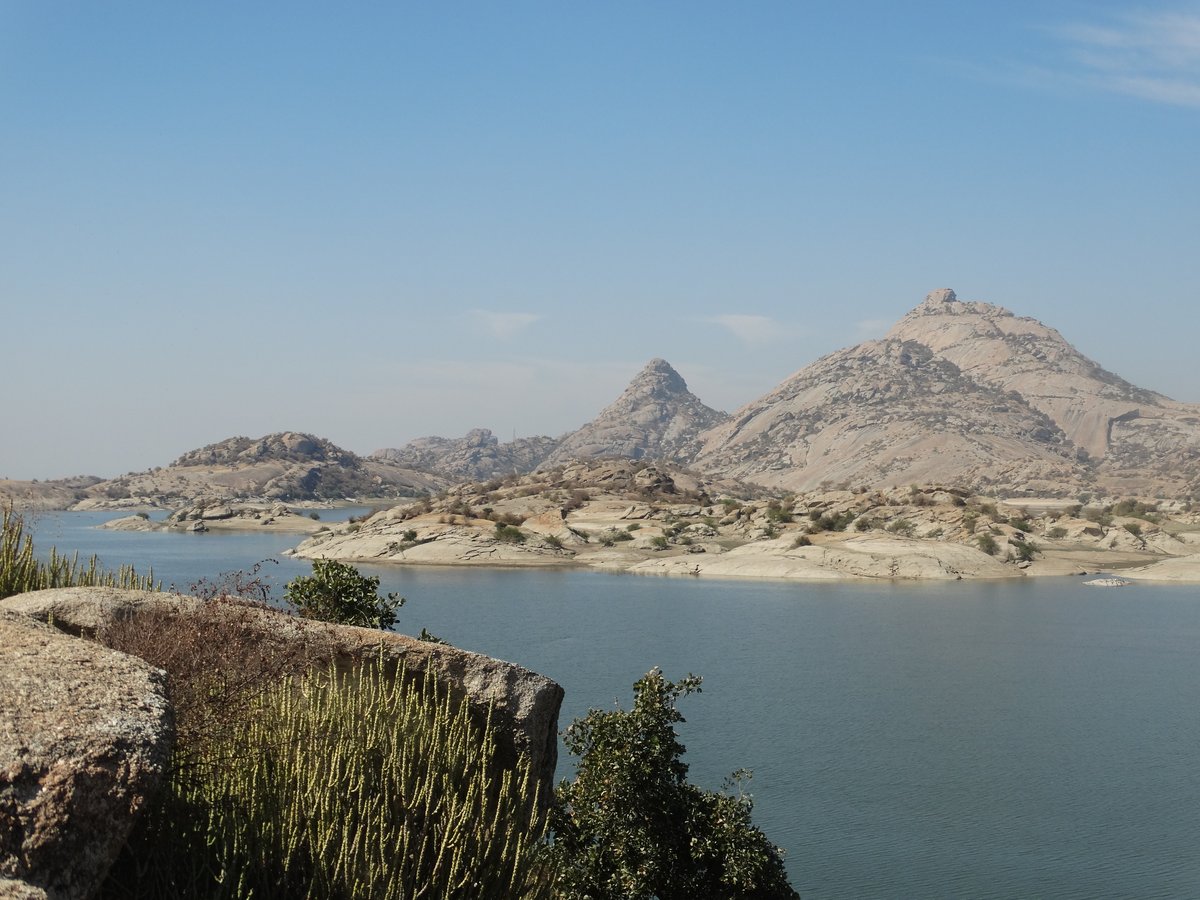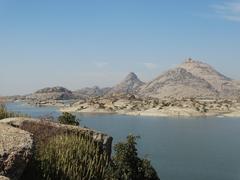
Comprehensive Guide to Visiting Jawai Dam, Sumerpur, India
Published Date: 01/08/2024
Introduction: Overview and Importance of Jawai Dam
Jawai Dam, located in Sumerpur, India, is a testament to both human ingenuity and natural splendor. Completed in 1957, this remarkable structure spans approximately 500 square kilometers and stands 61 feet tall, serving as a crucial water reservoir for the surrounding regions, including the Pali and Jalore districts (Wikipedia). Conceived initially in 1903 to mitigate flooding and later spearheaded by Maharaja Umaid Singh of Jodhpur, the dam’s construction began in 1946 under the supervision of state engineers and was completed a decade later (Tourism Rajasthan).
The Jawai Dam is not only an engineering marvel but also a hub of cultural and ecological significance. It is home to a rich diversity of wildlife, including a significant population of leopards and migratory birds, making it a paradise for nature enthusiasts and bird watchers (Jawai Leopard Reserve). Additionally, it plays a pivotal role in the socio-economic fabric of the region, providing essential water resources for agriculture and household needs.
This comprehensive guide aims to provide potential visitors with all the necessary information to make their trip to Jawai Dam memorable. From its history and construction to its ecological importance and visitor tips, this guide covers everything you need to know about exploring this stunning destination.
Table of Contents
- Introduction
- History and Significance
- Geographical and Structural Details
- Cultural and Ecological Significance
- Socio-Economic Impact
- Tourism and Festivals
- Visitor Information
- Biodiversity
- FAQ
- Conclusion
- References and Further Reading
History and Significance
Conception and Construction
The idea of constructing a dam over the Jawai River was first conceived in 1903. The primary motivation was to mitigate the severe flooding that caused extensive damage to the Pali and Jalore districts during the monsoon season. However, it wasn’t until 1946 that the project began to take shape under the reign of Maharaja Umaid Singh of Jodhpur. The construction of the Jawai Dam commenced on May 12, 1946, and was completed in 1957 (Wikipedia).
The dam was built under the supervision of state engineers Edgar and Ferguson during the princely period. After the formation of Rajasthan, the project was completed under the guidance of Chief Engineer Moti Singh. The total expenditure on the construction was approximately Rs 27 million. The dam spans an area of about 500 square kilometers and has a capacity of 7887.5 million cubic feet (Tourism Rajasthan).
Purpose and Utility
The primary objectives of constructing the Jawai Dam were multifaceted. Initially, it aimed to protect the Pali district from flood-related damages. Additionally, the dam was intended to generate electricity through hydropower. However, the hydropower project was later suspended due to insufficient water pressure throughout the year, which was needed to meet irrigation demands (Jawai Leopard Reserve).
The dam serves as the main water supply source for the Pali district. When there is sufficient water in the reservoir, it also provides irrigation water to some villages in the Jalore district. This makes the Jawai Dam crucial for agricultural activities in the region (Wikipedia).
Geographical and Structural Details
The Jawai Dam is built on the Jawai River, a tributary of the Luni River. The dam covers an area of 13 square kilometers and stands at a height of approximately 61.25 feet (18.67 meters). The catchment area of the dam site is 720 square kilometers, and the basin is fan-shaped. The dam encompasses 102,315 acres of fertile agricultural land (Wikipedia).
The Sei Dam and Kalibor Dam are feeder dams for the Jawai Dam. The Sei project, located in Kotda tehsil of Udaipur, was created specifically to supply water to the Jawai Dam (Tourism Rajasthan).
Cultural and Ecological Significance
The Jawai Dam is not just an engineering marvel but also a cultural and ecological hotspot. It is often referred to as Amrit Sarovar or Man Sarovar of Marwar. The dam attracts numerous tourists, especially during the winter months when many migratory birds, including cranes and geese, flock to the area. The dam is also home to a significant population of crocodiles, with 377 recorded as of 2020 (Wikipedia).
The area around the dam is inhabited by the Rabari tribe, who are known for their unique cultural practices and historical background. The Rabari people worship the Hindu goddess Parvati and follow a matriarchal society where women hold significant power and rank (Jawai Leopard Reserve).
Socio-Economic Impact
The Jawai Dam has had a profound socio-economic impact on the region. It serves as the primary source of drinking water for the cities around it, including the Jodhpur and Pali districts. The dam also plays a crucial role in irrigation, supporting the agricultural activities of numerous villages in the Pali and Jalore districts (Tourism Rajasthan).
However, the dam has also been a source of contention. The Jawai Dam water dispute in Rajasthan’s Jalore district revolves around the allocation of water, particularly for the farmers in the region. This dispute has led to significant protests, including a ‘mahapadav’ staged by hundreds of farmers demanding their rightful share of the dam’s water (Wikipedia).
Tourism and Festivals
The Jawai Dam is a popular tourist destination and a famous picnic spot in the Pali district. The Ranakpur-Jawai Dam Festival is organized annually in December, featuring various attractive programs, including yoga sessions, nature walks, camel polo, and gypsy and cycle safaris. Folk artists perform during this period, and various competitions and activities are organized to engage visitors (Tourism Rajasthan).
Visitor Information
Visiting Hours and Tickets
The Jawai Dam is accessible to visitors from 8:00 AM to 6:00 PM daily. There is no entry fee, making it an affordable destination for all.
Travel Tips
- Best Time to Visit: The ideal time to visit the dam is during the winter months (November to February) when the weather is pleasant, and migratory birds are abundant.
- Photography: The early morning and late afternoon hours provide the best lighting for capturing the dam’s scenic beauty.
- Guided Tours: Consider hiring a local guide to explore the area and learn about its history and biodiversity.
Nearby Attractions
- Jawai Leopard Reserve: Known for its leopard sightings, this reserve is a must-visit for wildlife enthusiasts.
- Ranakpur Temple: Located a short drive away, this temple is renowned for its stunning architecture and serene ambiance.
Biodiversity
The Jawai Dam area is renowned for its rich biodiversity. It is a hotspot for leopard sightings, bird watching, and a large crocodile population. Many migratory bird species are spotted here during the winter season, making it a paradise for bird watchers and nature enthusiasts (Wikipedia).
FAQ
- What are the visiting hours for Jawai Dam? The dam is open to visitors from 8:00 AM to 6:00 PM daily.
- How much are the tickets for Jawai Dam? There is no entry fee for visiting the dam.
Conclusion: Key Takeaways
In conclusion, Jawai Dam stands as a multifaceted landmark that encapsulates the essence of both human and natural achievements. From its inception in the early 20th century to its completion in 1957, the dam has significantly contributed to flood control, water supply, and agricultural irrigation in the Pali and Jalore districts (Wikipedia). Its cultural and ecological significance is equally remarkable, attracting tourists, nature enthusiasts, and researchers alike. The dam’s surroundings offer unique opportunities for wildlife safaris, birdwatching, and cultural excursions, providing a holistic experience for visitors (Jawai Leopard Reserve).
For those planning a visit, the winter months from November to February offer the best conditions for wildlife sightings and outdoor activities. With no entry fee and a range of nearby attractions like the Jawai Leopard Reserve and Ranakpur Temple, the Jawai Dam is an affordable and enriching destination (Tourism Rajasthan).
By following the guidelines and tips provided in this guide, visitors can ensure a safe, enjoyable, and memorable trip to Jawai Dam. Don’t forget to download our Audiala mobile app for more travel insights, check out related posts, and follow us on social media for updates.
References and Further Reading
- Wikipedia. Jawai Dam. Retrieved from Wikipedia
- Tourism Rajasthan. Jawai Bandh Dam. Retrieved from Tourism Rajasthan
- Jawai Leopard Reserve. Jawai Bandh History. Retrieved from Jawai Leopard Reserve
- Rajyatri. Jawai Leopard Safari. Retrieved from Rajyatri
- Holidify. Jawai Bandh Sightseeing. Retrieved from Holidify
- Worldwide Wander. Ultimate Guide to Things to Do in Jawai Rajasthan. Retrieved from Worldwide Wander
- Times of India. About Jawai Bandh in Rajasthan. Retrieved from Times of India
